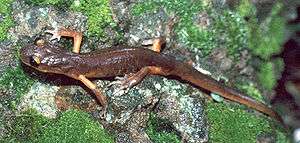Ensatina
| Ensatina | |
|---|---|
_03.jpg) | |
| Yellow-eyed Ensatina | |
| Scientific classification | |
| Kingdom: | Animalia |
| Phylum: | Chordata |
| Class: | Amphibia |
| Order: | Caudata |
| Family: | Plethodontidae |
| Genus: | Ensatina Gray, 1850 |
| Species: | E. eschscholtzii |
| Binomial name | |
| Ensatina eschscholtzii Gray, 1850 | |
| Synonyms | |
|
Ensatina klauberi | |
Ensatina eschscholtzii (commonly known by its genus name, Ensatina) is a complex of plethodontid (lungless) salamanders[2] found in coniferous forests, oak woodland and chaparral[3] from British Columbia, through Washington, Oregon, across California (where all seven subspecies variations are located), all the way down to Baja California in Mexico. The genus Ensatina originated approximately 21.5 million years ago.[4]
Habitat and description


The Ensatina subspecies E. e. eschscholtzii, or Monterey Ensatina, can be found in Santa Cruz, Monterey, and the California coastal mountains. They reach a total length of three to five inches, and can be identified primarily by the structure of the tail, and how it is narrower at the base. This salamander is the only type that has this tail structure and five toes on the back feet.
Males often have longer tails than the females, and many of the salamanders have lighter colored limbs in comparison to the rest of the body. The salamanders lay their eggs underground, often in threes, which then hatch directly into salamanders, skipping the usual aquatic phase.
As a ring species
The Ensatina salamander has been described as a ring species in the mountains surrounding the Californian Central Valley.[2] The complex forms a horseshoe shape around the mountains, and though interbreeding can happen between each of the 19 populations around the horseshoe, the Ensatina eschscholtzii subspecies on the western end of the horseshoe cannot interbreed with the Ensatina klauberi on the eastern end.[5] As such it is thought to be an example of incipient speciation, and provides an illustration of "nearly all stages in a speciation process" (Dobzhansky,1958).[2][6] Richard Highton argued Ensatina is a case of multiple species and not a continuum of one species (meaning, by traditional definitions it is not a ring species)[7]
Human contact
The ensatina can usually be found under logs or brush, by or in streams and lakes, and in other moist places. Because they breathe through their pores, distress in the animal can be caused by improper handling by human hands. They may exude a toxic milky secretion from the tail.[3]
Subspecies
.jpg)
- Yellow Blotched Ensatina — E. e. croceater (Cope, 1868)
- Monterey Ensatina — E. e. eschscholtzii Gray, 1850
- Large Blotched Ensatina — E. e. klauberi Dunn, 1929
- Oregon Ensatina — E. e. oregonensis (Girard, 1856)
- Painted Ensatina — E. e. picta Wood, 1940
- Sierra Nevada Ensatina — E. e. platensis (Jiménez de la Espada, 1875)
- Yellow Eyed Ensatina — E. e. xanthoptica Stebbins, 1949
References
- ↑ Hammerson et al. (2004). Ensatina eschscholtzii. 2006. IUCN Red List of Threatened Species. IUCN 2006. www.iucnredlist.org. Retrieved on 12 May 2006.
- 1 2 3 Wake, D. (1997) Incipient species formation in salamanders of the Ensatina complex Proceedings of the National Academy of Sciences USA 94:7761-7767
- 1 2 Monterey Ensatina San Diego Field Station, United States Geological Survey Viewed: April 24, 2005, Last updated: March 05, 2003
- ↑ Carl T. Bergstrom; Lee Alan Dugatkin (2012). Evolution. Norton. p. 468. ISBN 978-0-393-92592-0.
- ↑ Dawkins, R. (2004) The Ancestor's Tale: A Pilgrimage to the Dawn of Life ISBN 0-618-00583-8, Ring Species (The Salamander's Tale)
- ↑ Dobzhansky T. (1958) in A Century of Darwin, ed Barnett S A (Harvard Univ. Press, Cambridge, MA), pp 19–55.
- ↑ Highton, Richard (June 1998). "Is Ensatina eschscholtzii a Ring-Species?". Herpetologica 54 (2): 254–278.
External links
 Data related to Ensatina at Wikispecies
Data related to Ensatina at Wikispecies Media related to Ensatina eschscholtzii at Wikimedia Commons
Media related to Ensatina eschscholtzii at Wikimedia Commons- Ensatina Salamander page at Santa Rosa Junior College Department of Life Sciences
- Ensatina Salamander page at AmphibiaWeb
